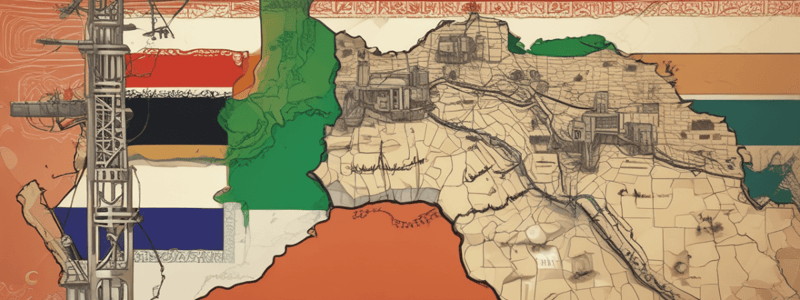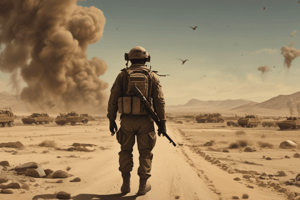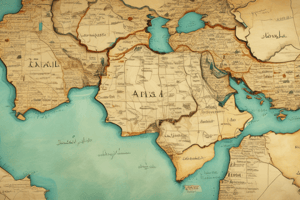Podcast
Questions and Answers
What was the nature of the external pressure on Iran and Iraq?
What was the nature of the external pressure on Iran and Iraq?
- Verbal, in the form of UN resolutions (correct)
- Diplomatic isolation
- Economic sanctions
- Military interventions
What was a significant consequence of the US's regime change in Iraq in 2003?
What was a significant consequence of the US's regime change in Iraq in 2003?
- A new era of relations between Shia Iran and Shia majority Iraq (correct)
- The formation of a new alliance between Iran and the US
- Increased violence between Iran and Iraq
- The escalation of the Iran-Iraq War
What has been the trend in hostile acts between Iran and Iraq since the end of the Iran-Iraq War?
What has been the trend in hostile acts between Iran and Iraq since the end of the Iran-Iraq War?
- A temporary increase followed by a decline
- No change
- A notable decline (correct)
- A significant increase
What is a necessary condition for conflict resolution, but not always sufficient to ensure reconciliation?
What is a necessary condition for conflict resolution, but not always sufficient to ensure reconciliation?
What is a characteristic of the current state of relations between Iran and Iraq?
What is a characteristic of the current state of relations between Iran and Iraq?
What event in 638 C.E. contributed to the historical roots of the con ct between Iran and Iraq?
What event in 638 C.E. contributed to the historical roots of the con ct between Iran and Iraq?
What was the primary concern of Iraq regarding Iran's actions in 1930?
What was the primary concern of Iraq regarding Iran's actions in 1930?
Which organization attempted to mediate the con ct between Iran and Iraq in 1934?
Which organization attempted to mediate the con ct between Iran and Iraq in 1934?
What is the primary source of Iraq's foreign exchange?
What is the primary source of Iraq's foreign exchange?
What has been the main point of contention between Iran and Iraq?
What has been the main point of contention between Iran and Iraq?
What was Iran's condition for accepting mediation in 1934?
What was Iran's condition for accepting mediation in 1934?
When did Iraq acquire formal statehood?
When did Iraq acquire formal statehood?
What cultural difference between Iran and Iraq contributed to the con ct?
What cultural difference between Iran and Iraq contributed to the con ct?
What is the Shatt-al-Arab's significance to Iran?
What is the Shatt-al-Arab's significance to Iran?
What event marked the beginning of the Islamic Arab military triumph over the Sassanian Empire?
What event marked the beginning of the Islamic Arab military triumph over the Sassanian Empire?
What event in 2003 led to the replacement of a predominantly Sunni regime by the long-suppressed Shia majority in Iraq?
What event in 2003 led to the replacement of a predominantly Sunni regime by the long-suppressed Shia majority in Iraq?
What was the outcome of the Iran/Iraq War?
What was the outcome of the Iran/Iraq War?
What is a possible reason for the non-resolution of the con ct?
What is a possible reason for the non-resolution of the con ct?
What is a consequence of the Iran/Iraq War?
What is a consequence of the Iran/Iraq War?
What is a potential outcome of the collective and individual exhaustion of both nations?
What is a potential outcome of the collective and individual exhaustion of both nations?
The Shatt-al-Arab connects Iraq to the Red Sea.
The Shatt-al-Arab connects Iraq to the Red Sea.
The Iran-Iraq conflict started in 638 C.E.
The Iran-Iraq conflict started in 638 C.E.
Iraq's national economy is primarily based on agriculture.
Iraq's national economy is primarily based on agriculture.
The Iran-Iraq War led to a formal peace treaty between the two countries.
The Iran-Iraq War led to a formal peace treaty between the two countries.
The League of Nations granted Iraq formal statehood in 1920.
The League of Nations granted Iraq formal statehood in 1920.
The UN imposed economic sanctions on Iran and Iraq during their conflict.
The UN imposed economic sanctions on Iran and Iraq during their conflict.
The Shia majority in Iraq was oppressed by Saddam Hussein's regime.
The Shia majority in Iraq was oppressed by Saddam Hussein's regime.
The Shatt-al-Arab is the key to Iraq's strategy for achieving hegemony in the Persian Gulf.
The Shatt-al-Arab is the key to Iraq's strategy for achieving hegemony in the Persian Gulf.
The modern phase of the con ct between Iran and Iraq began in the 19th century.
The modern phase of the con ct between Iran and Iraq began in the 19th century.
The Iran-Iraq War marked the beginning of a prolonged period of peace between the two countries.
The Iran-Iraq War marked the beginning of a prolonged period of peace between the two countries.
The overthrow of Saddam Hussein in 2003 led to a significant decrease in hostile acts between Iran and Iraq.
The overthrow of Saddam Hussein in 2003 led to a significant decrease in hostile acts between Iran and Iraq.
The Shatt-al-Arab Waterway is a maritime con ct that separates Iran from Iraq.
The Shatt-al-Arab Waterway is a maritime con ct that separates Iran from Iraq.
Iran made its acceptance of mediation in 1934 conditional on Iraq's cession of a significant portion of its territory.
Iran made its acceptance of mediation in 1934 conditional on Iraq's cession of a significant portion of its territory.
The League of Nations successfully mediated the con ct between Iran and Iraq in 1934.
The League of Nations successfully mediated the con ct between Iran and Iraq in 1934.
The con ct between Iran and Iraq began as a result of the Muslim Arabs' destruction of the Sassanid Empire in 638 C.E.
The con ct between Iran and Iraq began as a result of the Muslim Arabs' destruction of the Sassanid Empire in 638 C.E.
The Iran-Iraq War resulted in a decisive victory for Iraq.
The Iran-Iraq War resulted in a decisive victory for Iraq.
The 2003 US-led regime change in Iraq led to the replacement of a Shia regime with a Sunni majority.
The 2003 US-led regime change in Iraq led to the replacement of a Shia regime with a Sunni majority.
The Iran-Iraq War was fought from 1990 to 1991.
The Iran-Iraq War was fought from 1990 to 1991.
The exhaustion of both nations after the Iran-Iraq War led to a formal peace treaty.
The exhaustion of both nations after the Iran-Iraq War led to a formal peace treaty.
The Shatt-al-Arab waterway is of little significance to Iran.
The Shatt-al-Arab waterway is of little significance to Iran.
What has characterized the decline in hostile acts between Iran and Iraq since the end of the Iran/Iraq War?
What has characterized the decline in hostile acts between Iran and Iraq since the end of the Iran/Iraq War?
What is the significance of the US's regime change in Gulf War II for Iran and Iraq?
What is the significance of the US's regime change in Gulf War II for Iran and Iraq?
What is a key difference between changes in behavior and changes in attitudes towards a long-time enemy in interstate conflicts?
What is a key difference between changes in behavior and changes in attitudes towards a long-time enemy in interstate conflicts?
What is the relationship between formal conflict resolution and reconciliation?
What is the relationship between formal conflict resolution and reconciliation?
What is the current status of the conflict between Iran and Iraq?
What is the current status of the conflict between Iran and Iraq?
How did the destruction of the Sassanid Empire in 638 C.E. contribute to the historical roots of the con ct between Iran and Iraq?
How did the destruction of the Sassanid Empire in 638 C.E. contribute to the historical roots of the con ct between Iran and Iraq?
What was the primary issue that led to the initial internationalization of the con ct between Iran and Iraq in 1930?
What was the primary issue that led to the initial internationalization of the con ct between Iran and Iraq in 1930?
What was the outcome of the League of Nations' mediation effort in 1934?
What was the outcome of the League of Nations' mediation effort in 1934?
How did the rivalry between Iran and Iraq reflect deeper cultural and religious differences between the two nations?
How did the rivalry between Iran and Iraq reflect deeper cultural and religious differences between the two nations?
What was the significance of the Shatt-al-Arab waterway in the con ct between Iran and Iraq?
What was the significance of the Shatt-al-Arab waterway in the con ct between Iran and Iraq?
What is the strategic significance of the Shatt-al-Arab Waterway for Iraq?
What is the strategic significance of the Shatt-al-Arab Waterway for Iraq?
How did the Islamic Arab military triumph over the Sassanian Empire in 638 C.E. contribute to the historical roots of the Iran-Iraq conflict?
How did the Islamic Arab military triumph over the Sassanian Empire in 638 C.E. contribute to the historical roots of the Iran-Iraq conflict?
What is the primary source of conflict between Iran and Iraq, according to the text?
What is the primary source of conflict between Iran and Iraq, according to the text?
What is the significance of 1932 in the context of Iraq's history?
What is the significance of 1932 in the context of Iraq's history?
What is the relationship between territorial rivalry and the struggle for control over the Shatt-al-Arab Waterway?
What is the relationship between territorial rivalry and the struggle for control over the Shatt-al-Arab Waterway?
How did the outcome of the Iran/Iraq War influence the relationship between Iran and Iraq?
How did the outcome of the Iran/Iraq War influence the relationship between Iran and Iraq?
What was the significance of the 2003 event that replaced a predominantly Sunni regime with a Shia majority in Iraq?
What was the significance of the 2003 event that replaced a predominantly Sunni regime with a Shia majority in Iraq?
What is a possible reason for the non-resolution of the conflict between Iran and Iraq?
What is a possible reason for the non-resolution of the conflict between Iran and Iraq?
What was the geographical significance of the Shatt-al-Arab waterway in the conflict between Iran and Iraq?
What was the geographical significance of the Shatt-al-Arab waterway in the conflict between Iran and Iraq?
What historical event marked the beginning of the modern phase of the conflict between Iran and Iraq?
What historical event marked the beginning of the modern phase of the conflict between Iran and Iraq?
Flashcards are hidden until you start studying
Study Notes
Historical Background of Iran-Iraq Conflict
- The historical roots of the Iran-Iraq conflict date back to 638 C.E., when the Muslim Arabs destroyed the four-century Sassanid (Neo-Persian) Empire.
- The modern, post-World War I phase of the conflict began in the second decade of the inter-world war period (1919-1939).
Causes of the Conflict
- Three basic causes of the onset of the modern Middle East protracted conflict:
- Territory: The territorial dispute over the Shatt-al-Arab (Arab Waterway), which dates to the sixteenth century.
- Identity-religious and ethnic: Profound differences in culture and ethnicity (Persian-Iranian vs. Arab), religion (Shia vs. Sunni Islam), and historic rivalry between Middle East empires (Mesopotamia vs. Persia).
- Ideology: The struggle for power and hegemony in the Persian Gulf.
The Shatt-al-Arab Waterway
- The Shatt-al-Arab Waterway is crucial for the marketing of Iraq's oil, the most valuable element of its national economy and the primary source of its foreign exchange.
- Sovereignty over the Shatt has been vital to Iraq's national security.
- For Iran, control over the Shatt is the key to its strategy for achieving hegemony in the Persian Gulf.
Mediation Efforts and Consequences
- In 1934, Iraq complained to the League of Nations, which attempted to mediate a seemingly minor material dispute.
- Iran made its acceptance of mediation conditional on Iraq's cession of territory, which Iraq rejected.
- The failure of the mediation efforts led to the initial internationalization of the conflict.
Consequences of the Conflict
- The Iran-Iraq War resulted in a million or more fatalities and massive material losses.
- The conflict had profound psychological consequences in both societies.
- The absence of any human, political, or economic gains or compensation from the war led to a shared interest in resolving the conflict.
Decline in Conflict-Sustaining Acts
- Since the end of the Iran-Iraq War, state-organized, directed, and implemented violence between the principal adversaries has ceased.
- The decline in hostile acts against the longstanding rival and enemy has been notable, especially after the overthrow of Saddam Hussein in 2003.
- A new era between Shia Iran and Shia majority Iraq began as a consequence of the US's regime change in Gulf War II.
Conditions for Conflict Resolution
- The presence of one or more of the following conditions may indicate partial, informal conflict resolution:
- Exhaustion: Collective and individual exhaustion pervaded both nations.
- Changes in the balance of capability.
- Domestic pressures.
- External pressures.
- Reduction in discordance of objectives by the principal adversaries.
- Decline in conflict-sustaining acts.
Studying That Suits You
Use AI to generate personalized quizzes and flashcards to suit your learning preferences.




